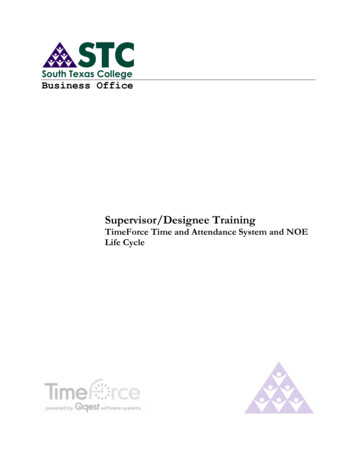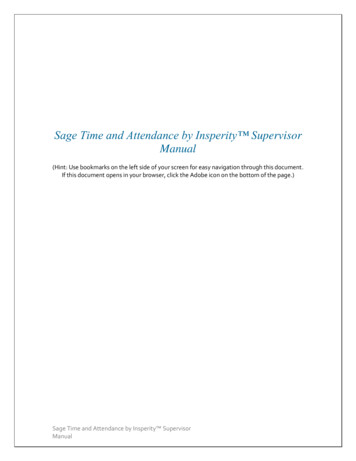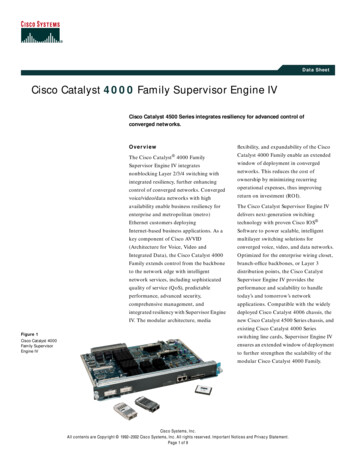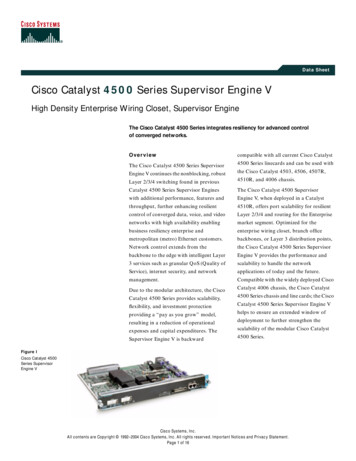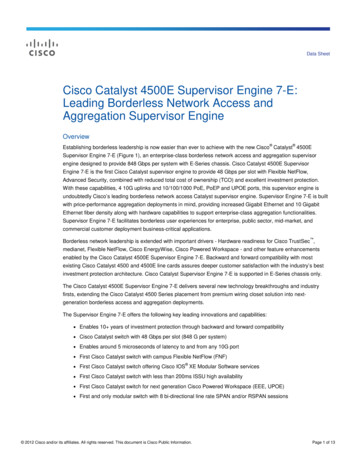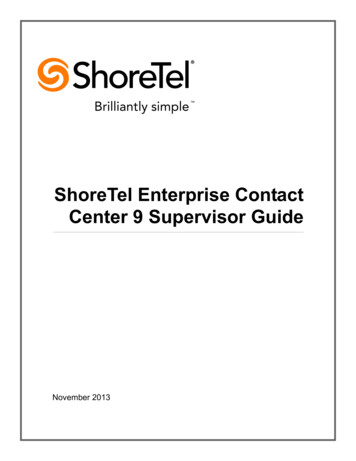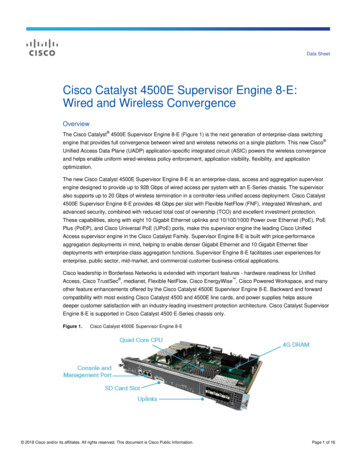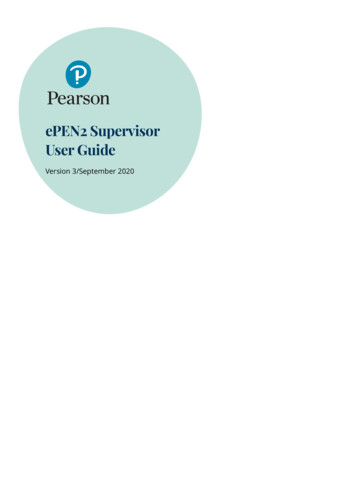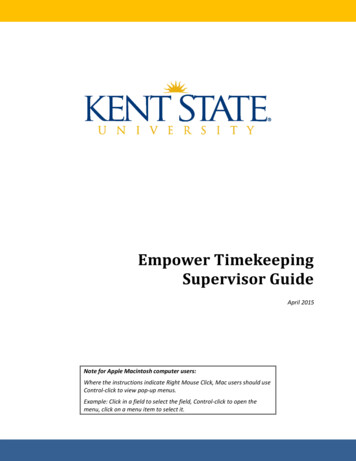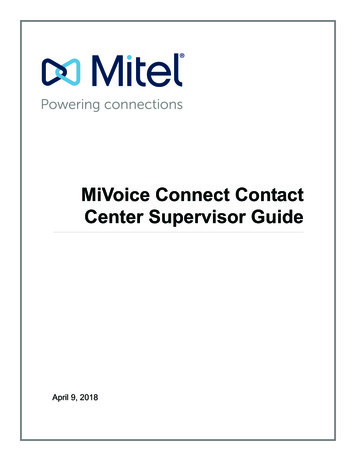
Transcription
ailSUPERVISOR TRAINING MANUALDealing With Workplace Performance Problems1 S u p e r v i s o r T r a i n i n g M a n u a lPartnering for Productivity and Profitability 800-873-7138 www.MINESandAssociates.com
2 S u p e r v i s o r T r a i n i n g M a n u a l
ContentsContents . 3Objectives . 4Good Daily Supervisory Practices: . 4Functions of an Employee Assistance Program . 4Management Consultation . 6Conflict Resolution Services . 6Steps to Follow:. 6Step 1 - Recognition. 7Indicators of Declining Job Performance . 7Signs and Stages of Burnout . 8The Four Stages Leading to Burnout:. 8Step 2 - Documentation . 9How to Document . 9What to Document . 9Step 3 - Action . 10Steps to Confronting Workplace Problems . 11Obstacles to Confronting Workplace Problems . 12Managing Your Anxiety . 12Step 4 - Referral. 13What Can Supervisors Expect from the EAP? . 13Step 5 - Follow-Up . 14Formal Work Performance Referrals (WPR) . 15Sample Formal Work Performance Referral Letter . 16Alcohol and Other Drugs in the Workplace . 17Workplace Violence. 18Critical Incident Support Services (CISS). 18EEOC, ADA, Sexual Harassment and FMLA . 19EEOC - Equal Employment Opportunity Commission. 19ADA - American with Disabilities Act . 19Sexual Harassment . 19FMLA - Family Medical Leave Act . 193 S u p e r v i s o r T r a i n i n g M a n u a l
ObjectivesAt the completion of this session, you should be able to: Understand how your organization’s EAP can be a management tool;Recognize the indicators of a job performance problem;Identify methods for documenting patterns or trends in the decline of a job performance;Identify how an individual’s job performance can also impact the performance of the manager orsupervisor;Identify when it is appropriate to refer someone to the EAP;Identify techniques that will aid you in constructively approaching the employee; andUse appropriate procedures for referring a person to the EAP.Good Daily Supervisory Practices: Continual assessment of personal strengths and weaknessesPractice effective communication skillsFamiliarity with your policies, procedures and disciplinary continuumUse of the EAP as a management toolFunctions of an Employee Assistance ProgramAn Employee Assistance Program, also known as an “EAP” is a worksite-based program designed to assist workorganizations in addressing productivity issues, and to assist the "employee-client" in identifying and resolvingpersonal concerns that may affect job performance.The benefit is a three-fold program incorporating services for the employee, supervisor and organization. The Employee: Receives problem assessment and short term counseling for themselves and theirhousehold members.The Supervisor: Has access to unlimited workplace consultation regarding work performance issues.The Organization: May participate in workshops, training programs, consultation and work/lifeservices.The EAP can serve as an ally to anyone who is working with a troubled employee. It is a good managementpractice to get another opinion when you are up against complex problems. The EAP can act as yourconsultant and by using it, you will assist your employee in securing the help he or she needs without burningyourself out.Supervisory consultation is available 24 hours a day. This service includes assisting supervisors, managers,foremen, personnel representatives, division administrators and department executives with employeeconflicts, performance problems or workplace issues.4 S u p e r v i s o r T r a i n i n g M a n u a l
The EAP identifies, and if necessary refers for treatment, employees who exhibit health and personalproblems, which impact their lives and their jobs. Problems which bring an employee to the EAP may includesome of the following:Family Issues: Parent/Child Conflicts Adolescence Relationship Problems Child Care/Elder Care Issues Marital Problems Parenting Concerns Empty Nesting Legal/Financial IssuesStress Management: Anxiety Trouble Concentrating Sleep Problems Job Pressures Family Stress Relationship StressAddictions: Alcoholism Substance Abuse Gambling FoodLife Transitions: Loss of Loved One Job Loss Empty Nesting Mid-Life Issues Marriage Post-College IssuesEmotional Difficulties: Depression Anxiety Stress Grief Anger Management Postpartum DepressionWorkplace Difficulties: Lateness Accidents Conflicts with Co-Workers Absenteeism Trouble Concentrating Job Performance5 S u p e r v i s o r T r a i n i n g M a n u a l
Management ConsultationFrom time to time, situations arise where a supervisor is not sure how to respond to a particular behavior andquestions whether or not the EAP is the appropriate resource. The EAP is available on a 24/7 basis forconsultation on issues such as: Whether to refer an employee to the EAP;How best to respond to and manage difficult behavior in the workplace; andWhether training or some other form of group intervention (such as an organizational intervention or aconflict resolution) may be helpful for a particular situation.Conflict Resolution ServicesWhen a conflict on a work team arises and a neutral third party is indicated, the EAP is available. MINES isavailable to meet with those involved and assist with a workable resolution. There is no charge for thisservice. The supervisor documents the conflict between employees and what attempts have been madetowards resolution. The following steps are then followed:1. The supervisor calls MINES to request a conflict resolution meeting. The meeting may take place at theMINES office or on-site at the organization, whichever is most convenient.2. The MINES facilitator will contact the supervisor before the scheduled meeting for details and desiredoutcome.3. The facilitator will meet individually with each party involved, for about an hour, to hear each side.4. After all parties have been interviewed, the facilitator will bring everyone involved together to meetand discuss options, needs, concerns etc. The facilitator will share his/her observations and offersuggestions that will have a positive impact on the work group.5. If and when a workable solution is reached, each member is asked to sign an agreement stating whathe or she will be responsible for doing. Ideally, the employees will share this information with thesupervisor and discuss ways in which they will hold one another accountable for their agreements.6. Because of the nature of this intervention, the information is not confidential.7. The MINES facilitators will follow-up with the supervisor to discuss progress.Steps to Follow:1.2.3.4.5.Recognition: What are the signs and symptoms of the employee with a problem?Documentation: Which forms of documentation highlight patterns that are clues?Action: Which methods of approaching an employee are most effective?Referral: How can you maximize the changes that your employee will seek help?Follow-Up: How can you and the EAP work together to get your employee back to an acceptable levelof work?6 S u p e r v i s o r T r a i n i n g M a n u a l
Step 1 - RecognitionRecognizing that a problem exists and that the employee's work performance is deteriorating is the first step.Don't turn your back on the issues - chances are the problem will only get worse.Consider the following questions when making decisions regarding poor work performance: Does the employee lack job knowledge or skill?Can the employee do the job, but fails because of job related issues?Can the employee do the job, but fails because of non-job related issues?In the first two areas, a supervisor can often intervene directly. The third may be an opportunity to consultwith the EAP.It is most appropriate to approach an employee who may be experiencing problems when you have observeda pattern of declining job performance over a period of time. Below is a list of indicators that may be signs ofprogressive, problematic work behavior that must be documented. Keep in mind that this is not an exhaustivelist.Remember.Pattern Declining Job Performance Period of TimeIndicators of Declining Job PerformanceWork Performance: Lowered productivity Frequently changing work pace withextreme high and lows Limited attention span or impaired ability toconcentrate Errors in judgment Excessive waste Unreasonable fatigueAbsenteeism: Repeated absences, especially followingweekends or holidays Early departures or unexplaineddisappearances Increase in tardiness Absences without good reason or withincreasingly improbable excusesReliability: Procrastination Neglect of details Missed deadlinesPoor quality of workAttitudes and Habits: Unreasonable sensitivity to normal criticismfrom peers and supervisors Avoidance of fellow workers Unreasonable intolerance or suspicion Sudden shifts in mood Long lunch hours, long coffee breaks,frequent trips to the water fountain orrestroomPhysical Appearance: Obvious changes in personal grooming,dress or demeanor Observable physical changesSafety: Increase in personal injuries due toaccidents on and off job Carelessness in use of equipment Lack of concern for safety of others7 S u p e r v i s o r T r a i n i n g M a n u a l
Signs and Stages of Burnout Emotional exhaustionFeelings of being unappreciatedDetachmentChange of work styleReduced accomplishmentParanoiaBoredom and cynicism DisorientationIncreased impatience and irritabilityPsychosomatic complaintsNo sense of power or controlSuicidal thinkingDepressionThe Four Stages Leading to Burnout:OverDedicationOver-InvestmentIn the job.DillusionmentFrustrationDespairThe job fails to live up tothe expectations.Cynicism withco-workers andsupervisors.Sense of hopelessness,disappointment in selfand job; feeling trapped.Example of RecognitionOver the past few months, John S. has had several problems with his work. We discussed these problems approximatelytwo months ago but they continued. On April 12, we discussed them again and he was told that he would be asked toleave the company if the situation didn't change.John has gone from a dependable Account Representative to one whose work is sporadic. Complaints have come fromhis coworkers and also from his clients.From my discussion with him, his poor work record seems to be related to his continuous problems with his marriageand to his concern over what he described as a serious financial problem for his brother. When I asked him more, hesaid he didn't want to elaborate. He did say, however, that this was why he had borrowed money from some of hiscoworkers and had not paid them back yet.On the job, he has been irritable, moody and sometimes distant. He has been very sensitive to taking directions and hehas blamed others for some of his own work not being done. Some of the staff working under him have complained that S u psomee r v i sdeadlineo r T r a informationi n i n g M a nwhichu a l ledhis assignments are unrealistic and he has forgotten to communicate to his 8clientto our meeting this week.
Step 2 - DocumentationKeep employees informed about what is expected regarding their work performance. Keep an accurate andup-to-date file of the employee's work performance according to your company's policy - without it, yourapproach could turn out to be a case of “your word against mine." In addition, the employee may be unawarethat his or her job performance is affected. Providing "proof" helps the em
Whether training or some other form of group intervention (such as an organizational intervention or a conflict resolution) may be helpful for a particular situation. Conflict Resolution Services When a conflict on a work team arises and a neutral third party is indicated, the EAP is available. MINES is available to meet with those involved and assist with a workable resolution. There is .
